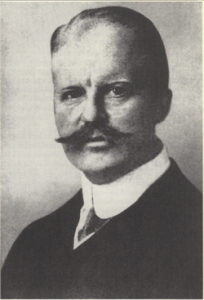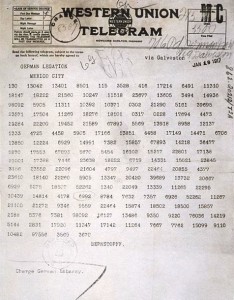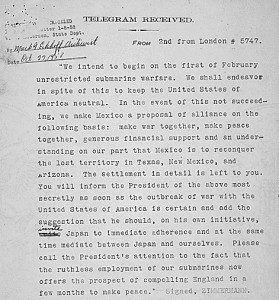ENIGMA Chapter 1 – Historical Background
CRYPTOLOGY IN WORLD WAR I
Radio communication
The invention of radio in the late 19th century had far-reaching consequences for military communication and cryptography. It enabled the exchange of messages with hitherto isolated locations (like ships at sea) and could be used to direct military campaigns. But it also made the need for secure encryption more important than ever.
Up until then the military had largely used the telegraph system (invented in 1837). This required a wire through which electrical pulses travelled between sender and receiver, and these messages could only be intercepted by directly accessing the cable. Radio transmissions, however, were omnidirectional and could be picked up by anybody with a receiver set to the correct frequency. Senders thus had to ensure that their communications were securely encrypted.
After the outbreak of World War I both sides were eager to take advantage of radio communication and its tactical possibilities, but were unsure about how to guarantee security. Cryptographers developed various new ciphers (which were largely variations of 19th century ciphers that had already been broken), but it wasn’t long before cryptanalysts were able to decipher them. One example was the so-called ADFGVX cipher, used by the Germans, who thought it was unbreakable. Georges Painvin at the French Bureau de Chiffre was, however, able to crack the code (losing 15kg of weight in the process) and crucial messages were read by the Allied forces.
Of all the wartime cryptanalysts, the French were the most successful, but the British and US Americans also made important contributions, for example with the British interception and decryption of the famous Zimmermann Telegram. Simon Singh writes in “The Code Book” [p.107]:
The story of this decipherment shows how cryptanalysts can affect the course of war at the very highest level, and demonstrates the potentially devastating repercussions of employing inadequate encryption.
The Zimmermann Telegram
Under President Woodrow Wilson the US remained neutral during the first two years of World War I. They traded food, supplies and weapons with the Allied forces, but were reluctant to be drawn into a bloody European war.
In 1915 the ocean liner Lusitania was sunk by a submerged German U-boat, killing 1198 passengers, including 128 US citizens. To prevent America from entering the war, Germany agreed to require their U-boats to surface before making an attack, a measure that was intended to prevent the accidental sinking of civilian ships.
In late 1916 the appointment of a new German foreign minister, Arthur Zimmermann, seemed to the Americans to herald a new age of enlightened German diplomacy. Behind the scenes, however, the situation was quite different. The stalemate in the European trench warfare led the German High Command to try to persuade the German Kaiser that unrestricted U-boat warfare was the only way to ensure a swift victory. Zimmermann was aware that this would probably draw the US into the war, and in order to deal with this possibility he devised a plan. He would send a telegram to Mexico proposing an alliance. If the US entered the war, Mexico should attack the US from the south in an attempt to reclaim Texas, New Mexico and Arizona.
 Germany would support their efforts against the common enemy with financial and military aid. In addition, Mexico should try to convince Japan to attack America.
Germany would support their efforts against the common enemy with financial and military aid. In addition, Mexico should try to convince Japan to attack America.
Zimmerman knew that all German transatlantic communications were being intercepted because of what had happened at the very beginning of the war. Before dawn on the very first day, the British had hauled up undersea cables on the German coast and severed the two transatlantic wires. This was forcing the Germans to send their telegraph messages via cables owned by other countries. President Wilson allowed the German government to send messages in its own code (to which the Americans did not have the key) between Berlin and Washington, which was contrary to accepted practice for neutral nations. On 16 January 1917 a heavily encrypted telegram was sent to the German Ambassador in Washington (who was instructed to forward it on to Mexico) over a US diplomatic cable. The wire made a landfall in England and was secretly being tapped by British Naval Intelligence, who intercepted Zimmermann’s message and sent it on to the Admiralty’s cipher bureau. Known as Room 40, it was staffed by an unusual mix of linguists, classical scholars and puzzle addicts.
In painstaking efforts the telegram was deciphered by Nigel de Grey and William Montgomery. Naval Intelligence realized that it would most likely draw the US into the war in support of the Allied forces, but they were faced with a problem: if the Americans publicly condemned the German proposal, the Germans would in turn deduce that their communications were being deciphered. They would then develop new and stronger encryption and thereby cut off a vital channel of intelligence. Admiral Hall, Director of Naval Intelligence, chose to wait and see how events unfolded.
The Germans began unrestricted naval warfare on 1 February 1917, but even though President Wilson broke off diplomatic relations with Germany, he kept stalling on the declaration of war, which he knew would be unpopular with large segments of the American population. This left the British no choice but to exploit the Zimmermann Telegram, and they handed it over to the US on 22 February. It was released to the press on 1 March, which lead to a public outcry and a shift in opinion. The United States formally declared war on Germany on 6 April 1917.
Naval Intelligence was, however, able to divert German suspicions: they had infiltrated the Mexican Telegraph Office and intercepted the Mexican version of the telegram, which was the version they gave the Americans. This copy was slightly different from the one originally sent to Washington (e.g. different recipient). At the same time, they planted bogus stories in the British press criticizing their own organization for not deciphering the telegram.
David Kahn writes in his extensive work on cryptology, “The Code-Breakers” [p. 297]:
No other single cryptanalysis has had such enormous consequences. Never before or since has so much turned upon the solution of a secret message. For those few moments in time, the codebreakers held history in the palm of their hand.
Encrypted Zimmerman Telegram
Deciphered Zimmerman Telegram
One-Time Pad Cipher
The invention of the one-time pad cipher, which theoretically cannot be broken if it is used correctly, is credited to two Americans: Major General Joseph O. Maubornge, head of cryptographic research for the US Army, and Gilbert S. Vernam of AT&T Bell Labs. Evidence has recently come to light that the California banker Frank Miller first developed this system in 1882, although it is unlikely that it was ever really used or that anybody other than his family and friends knew about it. Vernam and Maubornge began work on an electrical system based on teleprinter technology in 1917.
The most important aspect of this cipher is the key: it has to be completely random and must be longer than the message itself in order to avoid repetition and any kind of pattern. The key, which is printed on a punched tape, can also only be used once.
The cipher is based on the five-bit binary Baudot code (the teleprinter code in use until the invention of ASCII). Every character is represented by a series of five units, and each unit consists of either an electrical current (mark or 1) or its absence (space or 0) at any given time. For example, A is 11001 and B is 10011, and so on.
The random key is electrically added to the plaintext. The following rules apply:
1) mark + mark = space (1 + 1 = 0)
2) space + space = space (0 + 0 = 0)
3) mark + space = mark (1 + 0 = 1)
4) space + mark = mark (0 + 1 = 1)
If, for instance, the plaintext letter A (11001) is added the key letter B (10011), the result is R (01010).
Other developments by experts at the German Foreign Office in the 1920s involved a non-mechanized approach. Long random keys were printed on thick paper pads for one-time-only use, thus the name ‘one-time pad cipher’.
From a mathematical standpoint, if the cipher is used correctly, it is absolutely secure. If a cryptanalyst tried all different keys on a text consisting of ten letters, the result would be all messages of the same length, but there would be no indication of which one was correct. For example:
‘meet at dawn’
‘dogs like me’
‘do not reply’
Nonetheless, although this cipher is theoretically 100% secure, it is flawed in practice because of the difficulties involved in creating a large number of keys and safely distributing them in battlefield situations. In reality, the cipher has hardly ever been used, and then only for ultra-secret communications sent by those who could afford the enormous cost of manufacturing and safely distributing keys.
In the aftermath of WWI the search continued for a practical system for encryption. In the words of Simon Singh in “The Code Book” []:
In order to strengthen their ciphers, cryptographers were forced to abandon their pencil-and-paper approach to secrecy, and exploit the very latest technology to scramble messages.
This is when the Enigma machine first entered the scene.
—
Next chapters:
2 – The Invention of the Engima Machine
3 – The Substitution Cipher
4 – How Does the Machine Work? Part 1 and Part 2
FURTHER READING:
Books:
KAHN, David. The Code-Breakers – The Comprehensive History of Secret Communication from Ancient Times to the Internet. New York. 1996
SINGH, Simon. The Code Book – The Secret History of Codes and Code-Breaking. London. 1999
Articles:
BELLOVIN Steven Michael. Frank Miller: Inventor of the One-Time Pad. New York. 2011
http://academiccommons.columbia.edu/catalog/ac:135403
VON ZUR GATHEN Joachim. Zimmermann Telegram: The Original Draft. Cryptologia 31(1), 2–37. 2007 http://www.tandfonline.com/doi/abs/10.1080/01611190600921165
Websites:
Smithsonian Institute: Document Deep Dive – What did the Zimmermann Telegram say?
National Archives: Teaching with Documents – The Zimmermann Telegram





Write a comment
You need to be logged in to leave a comment.